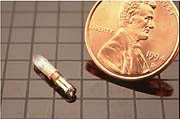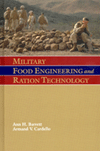
Controlling the work of Mother Nature has focused primarily on genetics and diet, and the application of significant amounts of technology is being used in livestock production. But managing the health of individual animals is extremely difficult, particularly when tens of thousands of animals are involved. RF-based identification tags injected subcutaneously are a step up from plastic tags attached to livestock’s ears, but they don’t reveal anything about the health of the individual animal. That’s why Digital Angel Corp., a South St. Paul, Minn., technology firm, developed a temperature-sensing, implantable microchip. Dubbed Bio-Thermo, the device recently received clearance from federal regulators for use in livestock and other animals.
Digital Angel’s CEO is Randolph K. Geisler, former owner of Fearing Manufacturing Co., a developer of plastic ear-tag IDs for livestock. Geisler grew up on a central Wisconsin dairy farm near Chippewa Falls and studied veterinary animal science in college. His firm specializes in miniaturization technology and has applied advanced sensors and global positioning systems to deliver condition monitoring systems for human beings, as well as RFID systems for animals. Food Engineering recently spoke with Geisler about the latest advances in microchip monitors for livestock.
FE: How can temperature-sensing, implantable microchips improve livestock production?
Geisler: We already have 30 million microchips implanted in pets and livestock that serve as radio frequency identification (RFID) tags. Bio-Thermo is the next step because it captures physiological data and relays it through scanners that interface with software that turns it into useful information.
Temperature is the most important parameter to monitor in livestock. Hogs are a highly bred species, and quick diagnosis of a sick animal is critical to avoid infection of the entire herd. Changes in body temperature are great indicators of health problems, but breeders aren’t able to capture that information in a feed lot or other environment. The only way to get it is with a rectal thermometer, and that takes a minute and a half with cows and pigs. It’s not anybody’s favorite job. Breeders are able to get periodic temperature readings from sows, but you can’t go into a pen with 50 feeders and collect the data.
In a beta test, we injected chips into 10 boars at a processing company’s farm. Temperature dictates semen quality, and these boars were being used to fertilize sows. We went to lunch, and when we came back, we found three of them had elevated temperatures, even though they all were presumed to be healthy.
If we devise a solution that causes people to do their jobs dramatically different, they’re not going to use the technology. With Bio-Thermo, workers simply pass one of our handheld scanners over the animal or have the animal walk through a portal scanner, and the system captures the temperature and matches it to the specific animal.
FE: Why was FDA and USDA clearance required?
Geisler: If you put a device in a food-producing animal, you have to do extensive toxicity studies and other safety studies to make sure that, if the device breaks or a human being ingests it, there wouldn’t be any harm done to either the human or the animal.
If you put this tag on the ear of the animal, wind and ambient temperatures would affect readings and other factors would compromise the data. To capture the correct temperature, the device has to be under the skin. The tag is injected into the cuneiform cartilage, where the ear attaches to the head, at birth. You now have a traceability device that can follow that animal all the way to the packinghouse. The harder part in all this are the scanners that communicate with that tag, and that’s primarily what is covered by the 20 patents associated with this system.

Geisler: The device looks like the lead inside a pencil and is smaller than a grain of rice. An antenna coil is wrapped around it and is hooked up to a unique, integrated circuit. When this inductively coupled transponder tag enters the sphere of a reader, the scanner pushes energy through the antenna to power up the integrated circuit, which in turn wakes up other sections of the device to grab data such as temperature. It then broadcasts that data to the scanner.
The magic of our PhDs was the electronic circuit. That devise took 3.5 years and $600,000 in development costs to design. Once they figured out the design and how they want the device to think, they contact a firm like Intel to fabricate it. The fabricator places layer upon layer of silicon and boron atoms to create an 8-inch plate that we can chop up. This is truly a case of real estate being the cost, and the more pieces we can chop that plate into, the lower the cost. At first, we could create 500; now we create about 7,000 devices per plate.
We drop the guts of the device inside a glass vile, use lasers to seal it and then sterilize it prior to implantation.
FE: What’s the value in electronic tracking of livestock?
Geisler: Even for the manufacturer of inanimate objects, RFID offers tremendous advantages. Imagine you have a factory with $5 million in inventory. Everything is in boxes, and the contents are marked on the outside of the box. At the end of the year, you perform a physical audit, and you can’t find $250,000 in inventory.
If you’re Tyson Foods, you have 250 million 3-lb. piglets that are going to grow to be 250 lb. hogs in six months. They don’t stay on a shelf or a pallet like boxed items. How do you keep track of that inventory? You have to have something more logical than ear tags to track them.
FE: How extensively are RFID tags currently used in animal tracking?
Geisler: We sell millions of chips to the U.S. Fish and Wildlife Service to track salmon in the Northwest. Twenty years ago, 50,000 salmon a day returned on the Columbia and Snake rivers. Now only 5,000 a day return. When a species is facing possible extinction, the government is compelled by law to investigate. We’re currently working with ichthyologists to determine what parameters are important to understand. Did the dams stop them from returning, or did something happen in the ocean? Temperature is nice to know, but is it critical in this case?
With Bio-Thermo, the plan is to launch it first in the dog and cat world to build volume and drive down costs before rolling it out for livestock in the fall. The pet market has huge elasticity to spend money. When you take your pet to the vet’s office, they begin the exam by digitally weighing the animal, getting the rectal temperature and digging out the pet’s records so they can record the data. With a microchip, you can scan the animal and accomplish all three things.
FE: What additional conditions might future generations of Bio-Thermo measure?
Geisler: We know that animals are going to have different estrogen cycles, different antibodies in them. In the next two to three years, we’ll develop chips that can sense progesterone levels for optimum fertilization and the presence of viruses that cause PRRS (porcine reproductive and respiratory syndrome) and other illnesses that can threaten a herd.
What we’re really excited about, though, is the ability to one day select a given disease, go to a pharmaceutical manufacturer who can make the treatment for that condition and then marry the two technologies so that the device can detect it and communicate with another device that would release the medication to treat it.
FE: Can you deliver this technology at a price that’s affordable?
Geisler: Including the software and the scanners, we estimate the cost will be in the range of $2.50 to $5 per chip. Pricing variability is a function of what kind of information and in what formats the user wants. Food companies are skeptical and thrifty, but they adopt technology quickly when they see value, and this has tremendous value, not only to improve the way companies currently operate but also to give them information that previously was unavailable.


